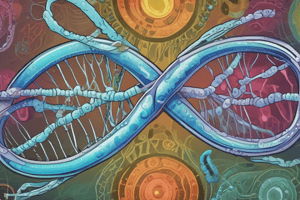Podcast
Questions and Answers
Sister chromatids are genetically identical.
Sister chromatids are genetically identical.
True (A)
Homologous chromosomes are always identical.
Homologous chromosomes are always identical.
False (B)
Humans have 23 homologous chromosome pairs.
Humans have 23 homologous chromosome pairs.
False (B)
Synapsis occurs during meiosis II.
Synapsis occurs during meiosis II.
Crossing over occurs between sister chromatids.
Crossing over occurs between sister chromatids.
Meiosis results in four diploid daughter cells.
Meiosis results in four diploid daughter cells.
Genetic variation can be caused by mutations.
Genetic variation can be caused by mutations.
Gene flow reduces genetic variation between populations.
Gene flow reduces genetic variation between populations.
Genetic variation can lead to traits that are both beneficial and detrimental to a species.
Genetic variation can lead to traits that are both beneficial and detrimental to a species.
Meiosis results in two diploid cells.
Meiosis results in two diploid cells.
Crossing over, a key contributor to genetic variation, occurs during prophase-II of meiosis.
Crossing over, a key contributor to genetic variation, occurs during prophase-II of meiosis.
Independent assortment and genetic recombination are the two main mechanisms by which meiosis contributes to genetic variation.
Independent assortment and genetic recombination are the two main mechanisms by which meiosis contributes to genetic variation.
Fertilization contributes to genetic variation through the random fusion of gametes.
Fertilization contributes to genetic variation through the random fusion of gametes.
Somatic mutations are passed on to offspring.
Somatic mutations are passed on to offspring.
Mutations are always harmful to organisms.
Mutations are always harmful to organisms.
Chemical mutagens can cause base pair mismatching in DNA.
Chemical mutagens can cause base pair mismatching in DNA.
Biological mutagens, like viruses and bacteria, can contribute to cancer formation by causing DNA damage.
Biological mutagens, like viruses and bacteria, can contribute to cancer formation by causing DNA damage.
Mutagens enhance the normal DNA repair mechanisms, leading to increased genetic stability.
Mutagens enhance the normal DNA repair mechanisms, leading to increased genetic stability.
Flashcards
Gene Flow
Gene Flow
The movement of organisms and genetic material affecting genetic variation.
Genetic Variation
Genetic Variation
Differences in DNA among individuals, essential for evolution.
Meiosis
Meiosis
The process that generates gametes through two main phases, reducing chromosome numbers.
Crossing Over
Crossing Over
Signup and view all the flashcards
Independent Assortment
Independent Assortment
Signup and view all the flashcards
Random Fertilization
Random Fertilization
Signup and view all the flashcards
Somatic Mutations
Somatic Mutations
Signup and view all the flashcards
Germ-line Mutations
Germ-line Mutations
Signup and view all the flashcards
Mutagens
Mutagens
Signup and view all the flashcards
Types of Mutations
Types of Mutations
Signup and view all the flashcards
Chromosomes
Chromosomes
Signup and view all the flashcards
Sister Chromatids
Sister Chromatids
Signup and view all the flashcards
Homologous Chromosomes
Homologous Chromosomes
Signup and view all the flashcards
Gametogenesis
Gametogenesis
Signup and view all the flashcards
Synapsis
Synapsis
Signup and view all the flashcards
Study Notes
Chromosomes and Genetic Variation
- Chromosomes are composed of two sister chromatids, identical genetically.
- Homologous chromosomes have the same genes but are distinct due to variations.
- Humans have 22 pairs of homologous autosomal chromosomes and one pair of sex chromosomes (XY).
- Each homologous chromosome, one from each parent, is part of a homologous pair.
Meiosis and Genetic Recombination
- Gametogenesis (formation of sex cells) occurs in two stages: meiosis I and meiosis II.
- Meiosis I:
- Prophase I, specifically pachytene, involves synapsis (pairing) of homologous chromosomes, creating a tetrad.
- Homologous chromosomes exchange genetic material at chiasmata during crossing over.
- Crossing over requires synapsis.
- This process results in new combinations of genes.
- Meiosis II: further division of cells leading to four haploid gametes (sperm or egg cells).
Genetic Variation
- Genetic variation exists within species and between populations (differences in allele frequencies).
- Alleles are different versions of the same genes.
- Alleles are inherited on half from each parent.
- Sources of genetic variation:
- Germline mutations: occur in gametes and are passed on.
- Gene flow: movement of individuals and genetic material introduces new genes into populations.
- Sexual reproduction: independent assortment of chromosomes and crossing over lead to unique combinations of traits.
- Variations can be either advantageous (selected for) or disadvantageous (selected against).
- Some variations follow simple dominant-recessive patterns.
Meiosis and Fertilization
- Meiosis, followed by fertilization, are crucial for sexual reproduction maintaining life in multicellular organisms.
- Meiosis creates gametes.
- Fertilization of gametes forms a zygote.
- Meiosis consists of reductional (Meiosis-I) and equational (Meiosis-II) phases.
- Meiosis results in four haploid gametes from one diploid cell.
- Genetic variation arises in meiosis through:
- Independent assortment of chromosomes in Metaphase I
- Genetic recombination during crossing over in Prophase I.
- Random fertilization further contributes to variation.
- Variation is crucial for species survival, adapting to changing environments.
Mutations
- Mutations are changes in DNA sequence, creating variations within a population.
- Mutations lead to differences in traits (hair color, skin color, etc.)
- Mutations are critical for evolution.
- Types of mutations:
- Somatic mutations: occur in non-reproductive cells and are not heritable.
- Germ-line mutations: occur in reproductive cells and are heritable.
- Gene mutations: affect short segments of nucleotides.
- Chromosomal mutations: affect long segments of nucleotides.
- Causes of mutations: chance events and mutagens.
- Types of DNA changes: substitution, insertion, and deletion.
Mutagens
- Mutagens are agents causing damage to DNA.
- Types:
- Physical mutagens (radiation): produce free radical damage to DNA.
- Chemical mutagens: directly damage DNA bases, causing base pair mismatches.
- Biological mutagens (viruses/bacteria): cause DNA damage that can lead to cancer.
- Mutagens disrupt DNA repair mechanisms, leading to mutations.
- Mutagens can cause cells to use alternative repair mechanisms, which can bypass DNA proofreading and repair.
- Though many are harmful, mutations are the primary source of genetic diversity, driving evolution.
Studying That Suits You
Use AI to generate personalized quizzes and flashcards to suit your learning preferences.




